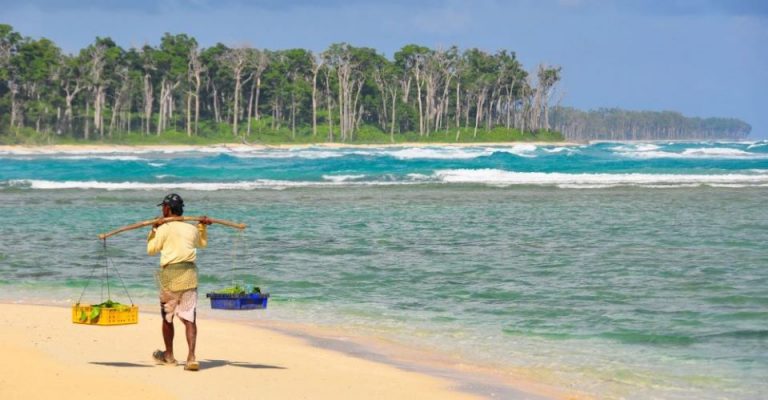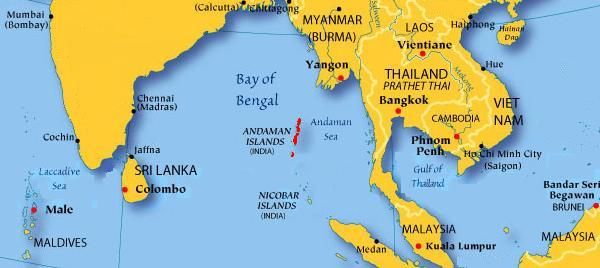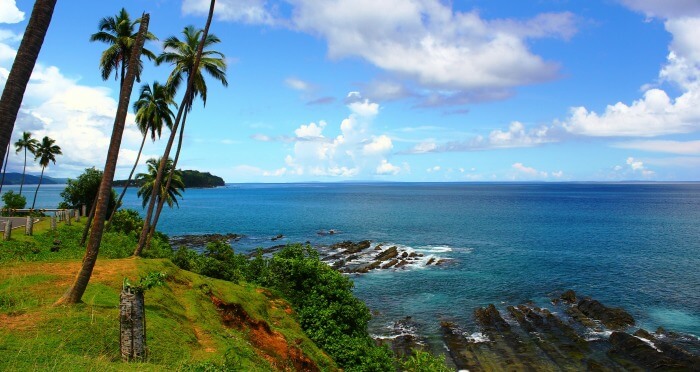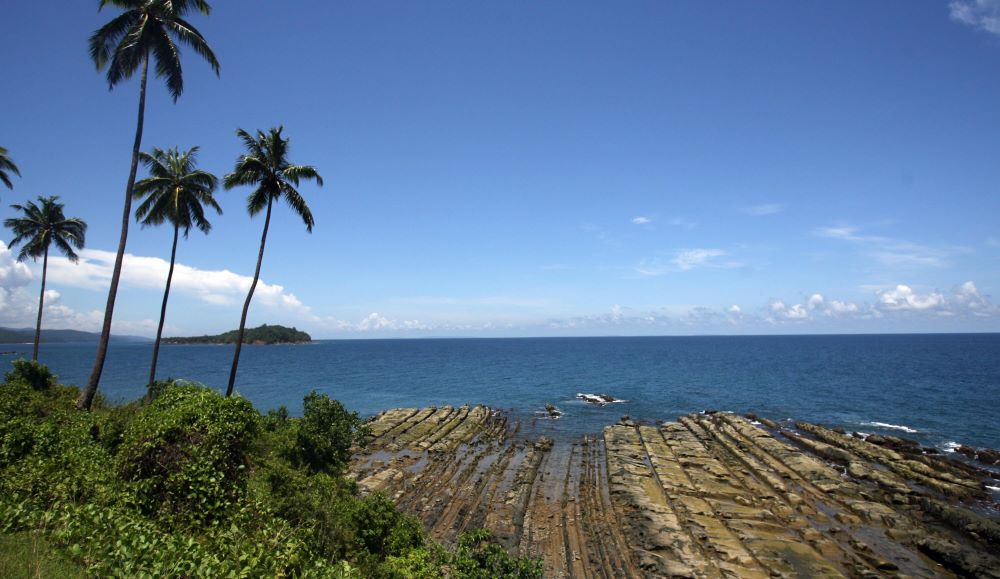
Colonial officials of different ranks tried to rationalize the phenomenon of same-sex behavior by employing (pseudo-)scientific theories of criminality, race and climatic determinism
[This article analyses colonial discourses on sodomy, jealousy and violence connected with the penal settlement, also known as ‘Black Waters‘, of the Andamans in late 19th and early 20th century. The narrative in these files elucidates the incoherent ways in which colonial officials of different ranks tried to rationalize the phenomenon of same-sex behavior by employing (pseudo-)scientific theories of criminality, race and climatic determinism. Moreover, the analysis tries to shed light on the manifold failures of the colonial regime in South Asia. The paper aims at contributing to the history of sexuality in colonial contexts by highlighting the role of colonial spaces as laboratories for emerging ‘European’ sexual theories.]
Manju Ludwig
‘Undesirable Pathans and Sindhis’: Racial taxonomies, moral panic and the report of the Indian Jails Committee of 1921
In 1920 an all-Indian Jails Committee was appointed by the Government of India to look into the conditions of the colonial penal institutions. The members of the committee visited the jails, conducted interviews with prison officers, warders, convicts and native experts, collected statistical and other material on the various jails and finally came up with a six-volume report by October 1920. The report generally painted a very unfavorable picture of the colonial jail system, and the Government of India had a heated debate about what impact this negative report would have on the anyway unstable political situation. It feared that the report would feed into the rising nationalist critique of colonial rule and thus decided to publish only the first volume, which contained the committee’s report, but not the five other volumes, which were the appendixes with the transcriptions of the interviews.
 The Indian Jails Committee criticized the penal settlement on the Andamans in particular and concluded that it was a complete failure. One of the reasons for assessing the settlement so negatively was the existence of ‘unnatural vice’ and its connection to murder cases. The report described the phenomenon in very frank terms which prompted one central officer to state that ‘the portion which deals with the Settlement is not pleasant reading’. The report transformed the already existing anxieties into a full-grown moral panic among the colonial officers who feared politically motivated criticism and allegations of moral failure from outside the colonial regime.
The Indian Jails Committee criticized the penal settlement on the Andamans in particular and concluded that it was a complete failure. One of the reasons for assessing the settlement so negatively was the existence of ‘unnatural vice’ and its connection to murder cases. The report described the phenomenon in very frank terms which prompted one central officer to state that ‘the portion which deals with the Settlement is not pleasant reading’. The report transformed the already existing anxieties into a full-grown moral panic among the colonial officers who feared politically motivated criticism and allegations of moral failure from outside the colonial regime.
The scandalous report called for immediate reaction and even before its publication the Superintendent of Port Blair was informed in January 1921 that temporary reforms and provisional measures were expected of him. The Superintendent M.W. Douglas proposed three temporary reform measures with regard to the necessary reduction in cases of ‘unnatural vice’. Firstly, he suggested that no convict should be sent to the settlement whose conduct gave reason to believe that he was a practitioner of sodomy. The Government of India took up this first proposal and ordered all local governments in January 1921 to stop sending those convicts ‘whose conduct has been under suspicion in connexion with unnatural vice’, thereby putting an end to the previous legal modus operandi of transporting persons convicted under Section 377, IPC to the islands. The second suggestion was to alter the age limit of convicts at the time of transportation from 25 to 45, because the Superintendent believed that the ‘unnatural crime’ was predominantly committed by younger men. Not surprisingly, the central government did not find it feasible to implement that proposition because it would have reduced the labor force on the Andamans considerably. The third suggestion touched on the issue of who was believed to be inclined to the ‘vice’, and it thus enhances our understanding on how the colonial regime tried to make sense of and categorized same-sex behavior. The Superintendent proposed to transfer all ‘undesirable Pathans and Sindhis’ from the penal settlement, because they were understood to be the main culprits in the exercise of the ‘unnatural crime’ and ‘specially addicted to unnatural vices’:

It is certain that definite improvement would result from the elimination of the Pathan and Sindhi convicts, some of whom, for the purpose of a penal settlement cannot be regarded otherwise than as ‘Moral Perverts’. Such men exercise a bad influence by their example, and it is improbable that they would import wives. If capable, and selected as petty officers, they acquire power, and frequently utilize it for the purposes of vice. If advanced criminals, they are so truculent as to render their control by other convicts practically impossible. I advise that measures be taken towards the transfer of all undesirable Pathans and Sindhis, and the importation of other classes in their places.
The Port Blair officers’ categorization of Pathans, Sindhis and Burmans as naturally addicted to ‘unnatural vice’ is reminiscent of Burton’s sexual mapping of the world
The central government was responsive to this suggestion and requested to be informed about the numbers of each class who would come within the terms of this definition. H.C. Beadon replied in April 1921 that ‘there is only one Pathan who is definitely proved to practice unnatural vice’ and the colonial regime ended up transferring one single convict to a mainland jail for the sake of immediate reform, thus proving the basis of this specific moral panic to be baseless.
The seemingly arbitrary conviction that Pathans and Sindhis were the main practitioners of sodomy is also mirrored in the report of the commission, which specified the respective characteristics of two groups by stating that ‘The Pathans enjoy a bad pre-eminence as the active agents in the matter, while the Burman is generally reputed to be the passive agent’. The groups the colonial penal regime affiliated with ‘unnatural vice’ were thus Pathans, Sindhis and Burmans. All three of these categories can be understood as a racial or ethnic entity and many of the colonial ideologies and governing techniques actually originated from such pseudo-scientific racial and ethnic taxonomies.

It shows the fraught nature of colonial power, which could not unite claims to certain civilizational standards and colonial realities
But it was not only racial or ethnic qualities that linked these men to a deviant form of sexuality, but also climatic and geographical characteristics. Of relevance for these ideas was the notorious geographer, colonial officer and Orientalist scholar Richard Francis Burton, who postulated in his famous Terminal Essay in the tenth volume of his translation of The Book of the Thousand Nights and a Night (1886) that there was a specific, geographically identifiable Sotadic Zone, in which ‘the Vice is popular and endemic’. The Port Blair officers’ categorization of Pathans, Sindhis and Burmans as naturally addicted to ‘unnatural vice’ is reminiscent of Burton’s sexual mapping of the world into two dichotomous realms—the Occident was depicted as heterosexual with only ‘sporadic’ outbursts of same-sex behavior while in most parts of the Orient the sexual deviance was supposedly endemic and tolerated. The regions from which the three concerned convict groups stemmed were all part of the Sotadic Zone. The discourse of geographically and thus also climatically constituted sexual otherness is very likely to have influenced the thinking of the officers in the penal settlement, also because colonial power relations were neatly embedded in the sexual characteristics in Burton’s sexual geography. The Andaman narratives added to Burton’s idea about sexual deviance an important novel characteristic, namely the intermingling of sexual deviance and the most extreme form of criminality, the murder impulse.
The Andamans as colonial scandal or as laboratory for sexual theories?
The scandal of the penal settlement lay mainly in the failure to live up to the stipulated colonial civilizing mission and the moral reform agenda. Narratives of sexual delinquency were evoked in order to veil deficiencies in the judicial procedures and the failure of the penal system as such. The motive of jealousy aroused by sodomitical passion had a relevant function in the judicial process of determining guilt of the convicts in murder cases and turned into an empty signifier which rendered further potentially self-critical enquiries by the judges unnecessary. By using derogative, demeaning terminology to describe sexual deviance, same-sex behavior was furthermore constructed by colonial officers as a social disease like prostitution, masturbation or transvestism.
Also read: Cellular Jail, Andaman Islands
But Apser Ali, Nga Shwe Yok and Balaka must not only be seen as embodying sexual Otherness—the narratives of their sexual inclinations also present the possibility for ambivalence and a more flexible reading of colonial sexual thought. Scholars of the history of sexuality have argued in other contexts that the contrasting of East and West in sexual terms posed a vehicle for the English sexual imagination and was part of a significant search for ‘truth’ in the late 19th century. The role of the colonies was crucial for this search, because it provided colonial officers and scholars with a sphere in which the study of sexual deviance could be undertaken more freely while in the European metropoles sexual discourses were restricted to fields such as the legal and medical professions, to religion and to underground pornography. The British Raj and especially the Andamans can be understood in this context as a laboratory for sexual theories, which were to meet the emerging cultural interest in male sodomy and a homosexual identity in the British society of the late 19th and early 20th centuries. The discursive combination of murder, sexual perversion and moral panic thus culminated in a colonial fantasy, which probably reveals more about British cultural constellations and developments than about South Asian ones.
The story of the colonial engagement with ‘unnatural vice’ is thus another example of how knowledge gathered and produced in the colonial realm fed into and interacted with supposedly European theories and how the construction of a specific homosexual identity must be seen as a transcultural process. Moreover, it shows the fraught nature of colonial power, which could not unite claims to certain civilizational standards and colonial realities.
Also read: Colonization, kidnap and confinement in the Andamans penal colony, 1771–1864
_____________________